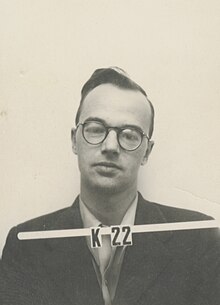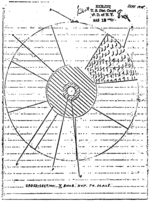User:Radical74/Nuclear espionage
Soviet spies in the Manhattan Project[edit]


During the Manhattan Project, the joint effort during World War II by the United States, the United Kingdom, and Canada to create the first nuclear weapons, there were many instances of nuclear espionage in which project scientists or technicians channeled information about bomb development and design to the Soviet Union. These people are often referred to as the Atomic Spies, and their work continued into the early Cold War. Because most of these cases became well known in the context of the anti-Communist 1950s, there has been long-standing dispute over the exact details of these cases, though some of this was settled with the making public of the Venona project transcripts, which were intercepted and decrypted messages between Soviet agents and the Soviet government. Some issues remain unsettled, however.
The most prominent of these included:
- Klaus Fuchs – German refugee theoretical physicist who worked with the British delegation at Los Alamos during the Manhattan Project. He was eventually discovered, confessed, and sentenced to jail in Britain. He was later released, and he emigrated to East Germany. Because of his close connection to many aspects of project activities, and his extensive technical knowledge, he is considered to have been the most valuable of the "Atomic Spies" in terms of the information he gave to the Soviet Union about the American fission bomb program. He also gave early information about the American hydrogen bomb program but since he was not present at the time that the successful Teller-Ulam design was discovered, his information on this is not thought to have been of much value.
- Theodore Hall – a young American physicist at Los Alamos, whose identity as a spy was not revealed until very late in the 20th century. He gave implosion bomb details to a Soviet official at a U.S. Communist party meeting in New York. From then, he continued to give information about the hydrogen bomb to his Soviet contacts. He was never arrested in connection to his espionage work, though seems to have admitted to it in later years to reporters and to his family. Near the end of his life, he admitted that he abhorred the idea of the United States holding overwhelming power over the world's nuclear stockpile and believed all nations should have the same amount of atomic knowledge.
- David Greenglass – an American machinist at Los Alamos during the Manhattan Project. Greenglass confessed that he gave crude schematics of lab experiments to the Russians during World War II. Some aspects of his testimony against his sister and brother-in-law (the Rosenbergs, see below) are now thought to have been fabricated in an effort to keep his own wife from prosecution. Greenglass confessed to his espionage and was given a long prison term.
- George Koval – The American-born son of a Belarusian emigrant family that returned to the Soviet Union where he was inducted into the Red Army and recruited into the GRU intelligence service. He infiltrated the US Army and became a radiation health officer in the Special Engineering Detachment. Acting under the code name DELMAR he obtained information from Oak Ridge and the Dayton Project about the Urchin (detonator) used on the Fat Man plutonium bomb. His work was not known to the west until he was posthumously recognized as a hero of the Russian Federation by Vladimir Putin in 2007.
- Ethel and Julius Rosenberg – Americans who were supposedly involved in coordinating and recruiting an espionage network which included David Greenglass. While most scholars believe that Julius was likely involved in some sort of network, whether or not Ethel was involved or cognizant of the activities remains a matter of dispute. Julius and Ethel refused to confess to any charges, and were convicted and executed at Sing Sing Prison.
- Harry Gold – American, confessed to acting as a courier for Greenglass and Fuchs.
While the spies mentioned previously have become infamous for their actions, more Los Alamos spies have been identified in recent years due in part to the FBI releasing previously classified documents. Other spies have become more known after being overlooked by historians.
These include:
- Clarence Hiskey - American-born chemist who worked on the Manhattan Project's metallurgical division and was serving as a Soviet agent. While working on the Manhattan project, he provided several classified documents to the GRU intelligence service. Though Hiskey's contributions to the Soviet Union's development of its own nuclear bomb remain minimal compared to other early spies, he remains one of the first to leak information from Los Alamos. He was never convicted by the U.S. government due to a lack of solid evidence pertaining to his espionage.
- Arthur Adams - a Soviet spy born in Sweden with mixed Russian and Swedish heritage. He served as a courier for Clarence Hiskey who was working at Los Alamos during World War II. Despite the fact he was not an American citizen, Adams was able to infiltrate the United States and convincingly faked his identity as a Canadian citizen. After successfully exporting many documents over the development of the U.S. atomic bomb, Adams fled back to the Soviet Union after several run-ins with the FBI.
- Oscar Seborer - an American electrical engineer assigned to work on the Manhattan Project within the Special Engineering Detachment. He is most notably known as the missing part of a group of Los Alamos scientists spying for the Soviet Union working. However, the quality of the information he leaked is still undecided due to the lack of documentation covering Seborer's time at Los Alamos. He went undiscovered until 2020 when historians Harvey Klehr and John Earl Hayes unearthed documents connecting Seborer to the previously known codename Godsend.
Most Soviet spies were properly convicted, but several evaded indictment due to a lack of evidence. In the case of Arthur Adams, he was watched by the FBI for many years before his escape to the Soviet Union. The FBI had probable cause Adams was engaging in espionage, but critically lacked evidence to proceed against him. The same goes for his associate Clarence Hiskey who was able to live the rest of his life out in the United States even though he was questioned by the FBI several times. Oscar Seborer was the most prevalent case of this, with his involvement not being discovered until decades after his spy work. Documents will continue to be found and more information about these spies and other potential saboteurs will become public knowledge.
References[edit]
https://ahf.nuclearmuseum.org/ahf/profile/theodore-hall/
https://thereader.mitpress.mit.edu/the-untold-story-of-the-first-u-s-based-nuclear-spy-and-how-he-got-away-with-it/#easy-footnote-bottom-11-14630
